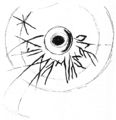VB·2
| Inscription | |
|---|---|
| Reading in transliteration: | oletuamaśilu |
| Reading in original script: | |
|
| |
| Object: | VB·2 Ornavasso (bottle) |
| Position: | shoulder, outside |
| Orientation: | 0° |
| Direction of writing: | sinistroverse |
| Script: | North Italic script (Lepontic alphabet) |
| Letter height: | 1.5–7 cm0.591 in <br />2.756 in <br /> |
| Number of letters: | 12 |
| Number of words: | 2 |
| Number of lines: | 1 |
| Workmanship: | scratched after firing |
| Condition: | complete |
|
| |
| Archaeological culture: | La Tène D [from object] |
| Date of inscription: | first half of 1st c. BC [from object] |
|
| |
| Type: | unknown |
| Language: | Celtic |
| Meaning: | 'Oletu, Amaśilu' or 'Oletu the Amaśilan' (?) |
|
| |
| Alternative sigla: | Whatmough 1933 (PID): 307 Solinas 1995: 131 Morandi 2004: 46 |
|
| |
| Sources: | Morandi 2004: 549 no. 46 |
Images
Commentary
First published in Bianchetti 1895: 69 (no. 19), 120. Examined for LexLep on 20th April 2024.
Images in Rhŷs 1914: pl. V (pencil tracing and reproduction of Bianchetti pl. XVIII.11), Tibiletti Bruno 1966: 12 (photo) and 13 (drawing), Piana Agostinetti 1972: tav. XXXI.11 (drawing), Solinas 1995: tav. LXXII (photo), Morandi 1999: 170 (drawing) and Morandi 2004: 548, fig. 11.46 (drawing).
Inscribed on the shoulder of the flask (length ca. 15 cm, distance between last and first letter ca. 8 cm). The letters vary strongly in height and are roughly executed, with many prolonged scratches (san, second lambda, upsilon, and alpha as in VB·1); the upper line of the white band appears to have been used as a rough guideline for the sequence amaśilu, which curves around the neck with large letters, while oletu is inscribed at an angle in overall smaller letters which do not fill the space between neck and band. An asterisk, scratched less deeply, is situated somewhat after and below the last letter; Morandi 1999: 169 f., no. 14 interprets is as a delimitation mark, but it may be unconnected to inscription.
Only the second part was seen and read as dextroverse ueśama by Bianchetti (thus also Kretschmer 1905: 98, no. 19); Rhŷs 1913: 61, no. 19, corrects to sinistroverse amaśiiu or amaśeu (with cursive Latin epsilon, s. already Herbig 1906: 195, 200, Danielsson 1909: 23; also Jacobsohn 1927: 30, no. 191), Rhŷs 1914: 26–28 adds the preceding sequence (uletu:amaśeu with uncertain separator; similarly Whatmough PID 307 uletu:amaśiiu, thus also Pisani 1964: 284, no. 120). Tibiletti Bruno 1966: 12–15 (already Tibiletti Bruno 1965d: 101, n. 87; see also Tibiletti Bruno 1968c: 356) corrects further to oletuamaśilu without separator, suggesting that amaśilu was written first and oletu added at a later point, maybe by the next owner; hence the change of angle between the two sequences, smaller letters in the first, and particularly crowded tu as the space was judged poorly. In fact, two dots, beneath each other are situated after upsilon exactly where a separator would be expected, but they may well be spots of damage on the abraded surface. Sceptical Lejeune 1971: 53 with n. 133, De Hoz 1990: 320 and Eska 1995: 43 f., who prefer a single inscription with two names (thus also Solinas 1995: 376, no. 131, Morandi 1999: 169 f., no. 14) and discuss the morphology of amaśilu as the expected patronym. Considering the generally untidy application of the inscription, it seems quite possible that the writer merely executed a course correction after the unsatisfactory execution of the first word. On the other hand, two-part names rather than just an individual name are rare on pottery, the only other examples being NO·16 and PV·1.
If the two sequences do represent a two-part name formula, the interpretation of amaśilu as a patronym/appositive is problematic (see the word page); otherwise, both qualify as on-stem personal names.
See also Piana Agostinetti 1972: 272, no. 11, Motta 1983: 65, n. 24, Morandi 1999b: 304–306, no. 2.
Bibliography
| Bianchetti 1895 | Enrico Bianchetti, I sepolcreti di Ornavasso [= Atti della Società di Archeologia e Belle Arti della provincia di Torino 6], Torino: Paravia 1895. |
|---|---|
| Danielsson 1909 | Olof August Danielsson, Zu den venetischen und lepontischen Inschriften [= Skrifter utgivna av Kungliga Humanistiska Vetenskaps-Samfundet i Uppsala 13.1], Uppsala – Leipzig: 1909. |
| De Hoz 1990 | Javier de Hoz, "El genitivo celtico de los temas en -o-", in: Francisco Villar (ed.), Studia indogermanica et palaeohispanica in honorem Antonio Tovar et Luis Michelena, Salamanca: Ediciones Universidad de Salamanca 1990, 315–329. |
| Eska 1995 | Joseph F. Eska, "Observations on the thematic genitive singular in Lepontic and Hispano-Celtic", in: Joseph F. Eska, R. Geraint Gruffydd, Nicolas Jacobs (eds), Hispano-Gallo-Brittonica. Essays in honour of Professor D. Ellis Evans on the occasion of his sixty-fifth birthday, Cardiff: University of Wales Press 1995, 33–46. |




